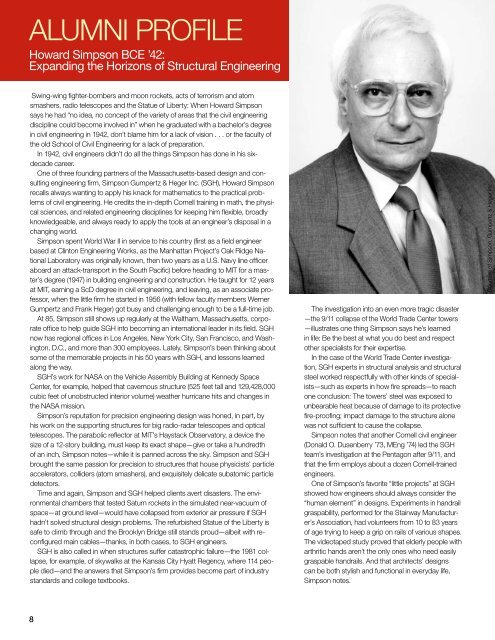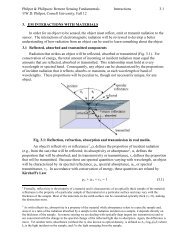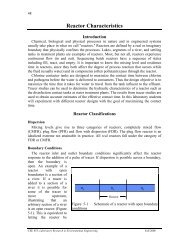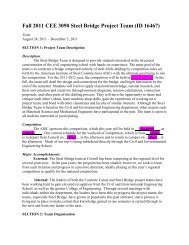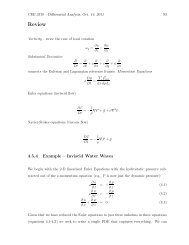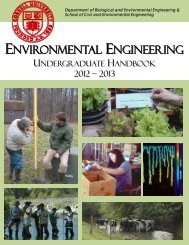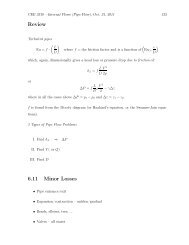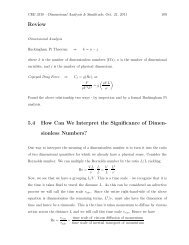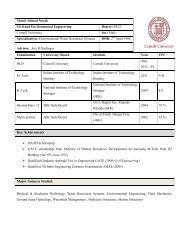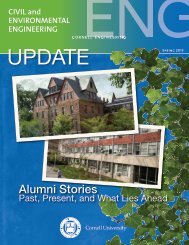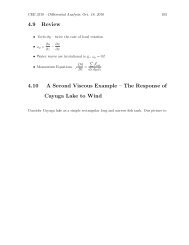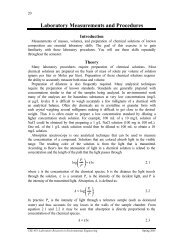Spring 2007 - Civil & Environmental Engineering - Cornell University
Spring 2007 - Civil & Environmental Engineering - Cornell University
Spring 2007 - Civil & Environmental Engineering - Cornell University
Create successful ePaper yourself
Turn your PDF publications into a flip-book with our unique Google optimized e-Paper software.
ALUMNI PROFILE<br />
Howard Simpson BCE ’42:<br />
Expanding the Horizons of Structural <strong>Engineering</strong><br />
Swing-wing fighter-bombers and moon rockets, acts of terrorism and atom<br />
smashers, radio telescopes and the Statue of Liberty: When Howard Simpson<br />
says he had “no idea, no concept of the variety of areas that the civil engineering<br />
discipline could become involved in” when he graduated with a bachelor’s degree<br />
in civil engineering in 1942, don’t blame him for a lack of vision . . . or the faculty of<br />
the old School of <strong>Civil</strong> <strong>Engineering</strong> for a lack of preparation.<br />
In 1942, civil engineers didn’t do all the things Simpson has done in his sixdecade<br />
career.<br />
One of three founding partners of the Massachusetts-based design and consulting<br />
engineering firm, Simpson Gumpertz & Heger Inc. (SGH), Howard Simpson<br />
recalls always wanting to apply his knack for mathematics to the practical problems<br />
of civil engineering. He credits the in-depth <strong>Cornell</strong> training in math, the physical<br />
sciences, and related engineering disciplines for keeping him flexible, broadly<br />
knowledgeable, and always ready to apply the tools at an engineer’s disposal in a<br />
changing world.<br />
Simpson spent World War II in service to his country (first as a field engineer<br />
based at Clinton <strong>Engineering</strong> Works, as the Manhattan Project’s Oak Ridge National<br />
Laboratory was originally known, then two years as a U.S. Navy line officer<br />
aboard an attack-transport in the South Pacific) before heading to MIT for a master’s<br />
degree (1947) in building engineering and construction. He taught for 12 years<br />
at MIT, earning a ScD degree in civil engineering, and leaving, as an associate professor,<br />
when the little firm he started in 1956 (with fellow faculty members Werner<br />
Gumpertz and Frank Heger) got busy and challenging enough to be a full-time job.<br />
At 85, Simpson still shows up regularly at the Waltham, Massachusetts, corporate<br />
office to help guide SGH into becoming an international leader in its field. SGH<br />
now has regional offices in Los Angeles, New York City, San Francisco, and Washington,<br />
D.C., and more than 300 employees. Lately, Simpson’s been thinking about<br />
some of the memorable projects in his 50 years with SGH, and lessons learned<br />
along the way.<br />
SGH’s work for NASA on the Vehicle Assembly Building at Kennedy Space<br />
Center, for example, helped that cavernous structure (525 feet tall and 129,428,000<br />
cubic feet of unobstructed interior volume) weather hurricane hits and changes in<br />
the NASA mission.<br />
Simpson’s reputation for precision engineering design was honed, in part, by<br />
his work on the supporting structures for big radio-radar telescopes and optical<br />
telescopes. The parabolic reflector at MIT’s Haystack Observatory, a device the<br />
size of a 12-story building, must keep its exact shape—give or take a hundredth<br />
of an inch, Simpson notes—while it is panned across the sky. Simpson and SGH<br />
brought the same passion for precision to structures that house physicists’ particle<br />
accelerators, colliders (atom smashers), and exquisitely delicate subatomic particle<br />
detectors.<br />
Time and again, Simpson and SGH helped clients avert disasters. The environmental<br />
chambers that tested Saturn rockets in the simulated near-vacuum of<br />
space—at ground level—would have collapsed from exterior air pressure if SGH<br />
hadn’t solved structural design problems. The refurbished Statue of the Liberty is<br />
safe to climb through and the Brooklyn Bridge still stands proud—albeit with reconfigured<br />
main cables—thanks, in both cases, to SGH engineers.<br />
SGH is also called in when structures suffer catastrophic failure—the 1981 collapse,<br />
for example, of skywalks at the Kansas City Hyatt Regency, where 114 people<br />
died—and the answers that Simpson’s firm provides become part of industry<br />
standards and college textbooks.<br />
The investigation into an even more tragic disaster<br />
—the 9/11 collapse of the World Trade Center towers<br />
—illustrates one thing Simpson says he’s learned<br />
in life: Be the best at what you do best and respect<br />
other specialists for their expertise.<br />
In the case of the World Trade Center investigation,<br />
SGH experts in structural analysis and structural<br />
steel worked respectfully with other kinds of specialists—such<br />
as experts in how fire spreads—to reach<br />
one conclusion: The towers’ steel was exposed to<br />
unbearable heat because of damage to its protective<br />
fire-proofing; impact damage to the structure alone<br />
was not sufficient to cause the collapse.<br />
Simpson notes that another <strong>Cornell</strong> civil engineer<br />
(Donald O. Dusenberry ’73, MEng ’74) led the SGH<br />
team’s investigation at the Pentagon after 9/11, and<br />
that the firm employs about a dozen <strong>Cornell</strong>-trained<br />
engineers.<br />
One of Simpson’s favorite “little projects” at SGH<br />
showed how engineers should always consider the<br />
“human element” in designs. Experiments in handrail<br />
graspability, performed for the Stairway Manufacturer’s<br />
Association, had volunteers from 10 to 83 years<br />
of age trying to keep a grip on rails of various shapes.<br />
The videotaped study proved that elderly people with<br />
arthritic hands aren’t the only ones who need easily<br />
graspable handrails. And that architects’ designs<br />
can be both stylish and functional in everyday life,<br />
Simpson notes.<br />
Courtesy of Simpson, Gumpertz & Heger Inc.


